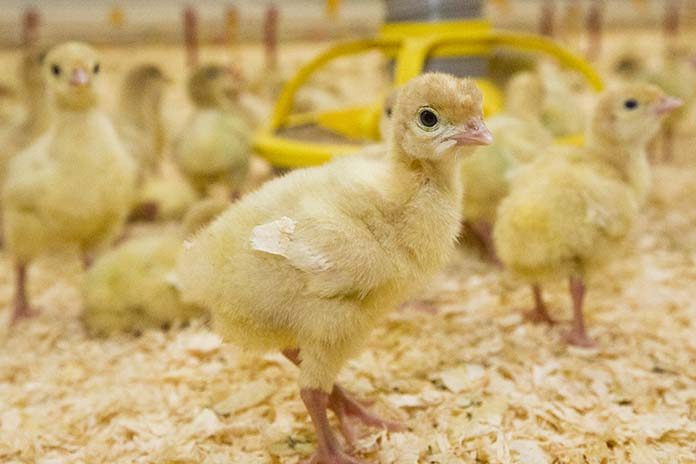
Alternative management – paying attention to detail and supportive care strategies can be utilized to produce turkeys without antibiotics in this new era.
Dr. Steven Clark, Devenish Nutrition, has done a great job documenting the health and production issues of the turkey industry in his annual industry survey. When reviewing this list over time, other than when Enrofloxacin was available, one of the top concerns has been “lack of approved, efficacious drugs” (#1 concern reported by the industry in 2015-2016). As the industry continues to move toward more ABF production, that statement will most likely change to “lack of approved, efficacious treatments”. Even if your operation has not been blessed with the distinction of being ABF, times have changed and the industry has lost a lot of tools at its disposal for treating disease. A short list is below – tools I have been able to use in my 30 years that are no longer available.
- Nitrofurans.
- Nitroimidazoles.
- Fluoroquinolones.
- Arsenicals.
- Penicillin combinations in the feed.
- Water combinations – example Pen/Strep.
Right, wrong, or indifferent, in many cases, we used these to “prevent” disease infection. Not only are antibiotics prohibited, but so are ionophores. So, we may be able to reduce pathogen load and stressors with preventative management, but cocci control is a different story.
What can the industry do to maximize genetic potential and practice sound animal welfare in the face of these changes?
We will look at management necessities that we have all heard over and over.
They include:
- Biosecurity (on farm – drawing a line in the sand and rodent and insect control),
- Water sanitation (biofilm andpathogen free water).
- Ventilation (controlling gases, humidity, and temperature).
- Brooding (getting birds off to the best start possible).
- Welfare (proper culling, ammonia control, and litter control).
- HE vaccination procedure (to control secondary infection).
Items that are most likely out of your control (especially if you are a contract producer) may include:
- Poult quality (without antibiotics, we need poults without bacterial challenges).
- Feed presentation (consistent quality is critical).
- Cocci control (may be up to the attending veterinarian), and
- Supportive care (may be up to the live production management).
Biosecurity – People, wild bird, rodent and insect control are all, without saying, a must. If you don’t have these in place, forget ABF. Starting clean and staying clean with a good cleaning and disinfection program is also a must. Single age (All-in, All-out) turkey production is also included in this discussion. Multi-age facilities are possible, but are a risk in ABF production. Moving birds from one location in brood and move is better than two-age, but still a stress on the animal.
Water sanitation – if you do not plan on using a sound water sanitation program, stop now. Forget ABF.
It will not work. Not only should you need a sound system, you need also to monitor with tried methods on at least a weekly basis, to make sure the system is working properly. If it is not working properly, fix it. For me, activated chlorine dioxide can be the simplest and most efficient method to provide a constant sanitized supply of drinking water to your poultry.
We spend a lot of time and money on our poultry facilities – new skid loaders, the best feeding and ventilation systems, etc., etc., but how much time and money do we spend on water? What is the most important nutrient our birds consume? Water.
Brooding and early feed consumption – the brood period, whatever timeline you use for that, is extremely critical for good performance. It starts before the birds hit the floor. Turkey production has finally caught up with broiler production, with many producers now using whole room or large ring brooding. Before the birds hit the floor, the temperature across the floor of the house must be balanced for bird comfort. See the picture. The temp around the feed and water – in this case the auto feeders and water (90-95°), keeps birds comfortable where they need it – around the feed and water. These temperatures are guidelines as every flock can react differently. However, by setting the barn up correctly, prior to bird arrival, and getting these temperatures at least 24-48 hours prior to placement, poults will be able to find their comfort zone and get on feed and water immediately. This helps set the feeding pattern early, promotes gut maturation and therefore early growth and immune response. This is especially important for flocks that are vaccinated for cocci control.
Ventilation – the diagram (www.poultryventilation.com) has been used for years to explain proper ventilation control on young birds or in cold weather. This is an important part of brooding and early feed consumption. This air control coupled with the correct BTU power from the heat, will allow us to control floor and room temperatures, reduce drafts, and control CO2 and humidity levels. All promoting healthy feeding patterns and growth.
Feed presentation and formulation – I cannot address feed formulation. I am not a nutritionist. But, I can address the importance of feed presentation, especially the first 4-5 weeks of the bird’s life. We need to do one of two things – either makes a consistently good crumb for whatever period you choose, or make a consistently bad crumb for the same period (even consider mash if necessary). If you provide a mixture of good crumb and fines, you will promote a confusion and poor feed intake as the birds’ age.
Supportive care – There are a lot of products that have shown up on the market with a lot of claims to be the silver bullet. I look at this class as being supportive care. We owe it to our pocket books and our birds to use tested products. Some of these products include the following in categories that I (a production guy) will classify them.
Gut health and ammonia control:
- Yucca products
- Probiotics – probiotics with bacillus and lactobacillus. Use products for poultry with defined levels. Probiotics (Enviro by Arm&Hammer) will reduce ammonia
- Oregano products.
Miscellaneous supportive care:
- Chick or Bogus paper – used to promote cocci cycling for vaccinated flocks and keeping birds on feed during stress
- Routine flock health monitoring – bleed flocks between 8-9 weeks of age and test for Reovirus, Bordetella, Newcastle, HE – make sure you know what challenges you flocks are
- Consider cleaning our barns more often, even every flock to control pathogen loads in ABF production.
- Use litter amendments to reduce litter and dirt floor pH levels for pathogen control.
Cocci control – cocci control in ABF production is a challenge, there’s no other way to put it. We kind of hold our breaths through the brood period to see if our program has been effective with each flock.
For ABF production, there is a limited number of programs that can be used depending on your customer. For some production, chemicals can be used on a rotation basis (when available), but not to be overused. For others, when cocci vaccine is available, can be effective if administered properly, monitored and followed with a sound supportive care program and consistent feed presentation. Botanicals have been used with mixed results.
Poor control typically leads to enteric issues and necrotic enteritis. Monitoring flock cocci control by measuring fecal oocyst counts (OPG) is a simple way to see where cocci levels are at different ages and if the vaccine we do use is cycling at the right levels and ages to promote immunity.
Poult quality – this goes without saying. ABF poults cannot be injected with antibiotics at the hatchery and we can’t use early “preventive” antibiotics after placement anymore.
HE vaccination – effective HE vaccination is critical in ABF production. We can’t use antibiotics to treat the typical E.coli we see at 7-10 weeks of age, that I usually attribute to poor immune response form ineffective vaccine or vaccination techniques. This will be an issue for the industry and we need to constantly look at methods to improve what I will call, subclinical HE/E.Coli due to poor HE control.
From the Proceedings of the Midwest Poultry Convention – 2018

















